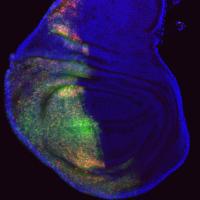
Polycomb repressive complex 2 (PRC2) was originally discovered in fruit flies as a transcriptional repressor. Historically, fly and human Polycomb proteins were considered textbook exemplars of transcriptional repressors, or proteins that silence the process by which DNA gives rise to new proteins. Now, work by a team of researchers at the Stowers Institute for Medical Research challenges that dogma.
In a cover story in the May 2012 issue of the journal Molecular and Cellular Biology, Stowers Investigator Ali Shilatifard, Ph.D., and his team report that in the fruit fly Drosophila melanogaster a component of the Polycomb repressive complex 2 (PRC2), which is called Jarid2, occasionally activates gene expression.
Polycomb proteins, a group of chromatin-binding factors, were initially found to control how developing fly embryos undergo segmentation. Subsequently, researchers discovered that humans also express a gaggle of proteins resembling fly Polycomb factors and that these proteins have crucially significant roles: under normal conditions PRC2 proteins are required for the differentiation of stem cells, but when overactive, act as oncogenes in lymphoma, breast, and prostate cancer.
"Our approach is to use Drosophila as a model to learn how Polycomb group proteins function in the context of cancer," says Shilatifard, who studies mechanisms underlying leukemia in yeast, fruit flies, and mammalian cells. "In this study, we found that a new component of the PRC2 complex, Jarid2, maintains repression of some genes, but also potentially activates other target genes."
In the usual fly-to-human discovery continuum, the current study represents a species turnaround. While investigators analyzing mammalian stem cells had shown that Jarid2 was an important component of PRC2 in mammals, its activity remained unknown in Drosophila. To determine whether it acted together with Polycomb PRC2 in flies, the Stowers team, led by postdoctoral researcher Hans-Martin Herz, Ph.D., applied a proteomic approach to enumerate every Drosophila protein binding to Jarid2 in fly embryos.
Predictably, they found that fly Jarid2 associates with the same protein suspects as it does in mammals. "Previous mammalian studies reported opposing findings in regard to the role of Jarid2 in the PRC2 complex," says Herz. "Some papers said Jarid2 inhibited PRC2 activity while others claimed Jarid2 activated it."
To settle the issue, the group undertook genome-wide profiling by scanning the entire fruit fly genome to determine where Jarid2 and other members of the PRC2 complex localized on DNA. Overall, the proteins showed similar distribution patterns along chromosomes, hinting that PRC2 complexes containing Jarid2 regulate many of the same genes. However, some genes known to be PRC2 targets showed very little occupancy by Jarid2, an observation that suggested Jarid2 does not share all of the characteristics of a core member of the PRC2 complex.
Combining state-of-the-art genomic approaches with classic fly genetics, the group then defined what Jarid2 actually does molecularly in cells. To do that, they compared gene expression profiles of larvae of two distinct types of genetically manipulated flies: those that lacked only Jarid2 expression and flies that lacked expression of a core PRC2 protein. The rationale was that if Jarid2 and the complex shared the same targets and acted in lockstep, those profiles should be identical.
Two surprising observations emerged from that study. First, in Jarid2 mutant flies, some Jarid2/PRC2 co-bound genes exceeded their normal expression and others were inhibited, the latter suggesting that Jarid2 does not always repress a target. Secondly, the pattern of gene expression observed in the Jarid2 flies differed significantly from that seen in the PRC2 mutants, meaning that whatever Jarid2 does biochemically does not mimic what other PRC2 proteins do.
"Our findings challenge the general idea that PRC2 has only a repressive role," says Herz. "In fact, they suggest that PRC2 and Jarid2 may regulate different genes in specific contexts."
Recent reports implicate Jarid2 in diseases as diverse as multiple sclerosis and schizophrenia. But most significantly for the Shilatifard lab are studies linking both PRC2 and Jarid2 to myeloid cancers such as leukemia. "The theme of our lab is factors that regulate the yin and yang of transcription," says Shilatifard, citing his interest in both of the Polycomb proteins and their polar opposites, the Trithorax activator proteins—initially characterized in flies and also linked to leukemia. "Our overall goal is to gain insight into both."
Source : Stowers Institute for Medical Research
 Print Article
Print Article Mail to a Friend
Mail to a Friend
